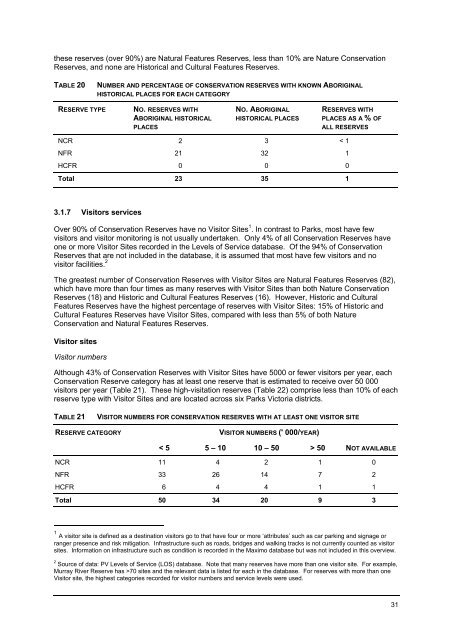Conservation Reserves Management Strategy 2003 - Parks Victoria
Conservation Reserves Management Strategy 2003 - Parks Victoria
Conservation Reserves Management Strategy 2003 - Parks Victoria
You also want an ePaper? Increase the reach of your titles
YUMPU automatically turns print PDFs into web optimized ePapers that Google loves.
these reserves (over 90%) are Natural Features <strong>Reserves</strong>, less than 10% are Nature <strong>Conservation</strong><strong>Reserves</strong>, and none are Historical and Cultural Features <strong>Reserves</strong>.TABLE 20NUMBER AND PERCENTAGE OF CONSERVATION RESERVES WITH KNOWN ABORIGINALHISTORICAL PLACES FOR EACH CATEGORYRESERVE TYPENO. RESERVES WITHABORIGINAL HISTORICALPLACESNO. ABORIGINALHISTORICAL PLACESRESERVES WITHPLACES AS A % OFALL RESERVESNCR 2 3 < 1NFR 21 32 1HCFR 0 0 0Total 23 35 13.1.7 Visitors servicesOver 90% of <strong>Conservation</strong> <strong>Reserves</strong> have no Visitor Sites 1 . In contrast to <strong>Parks</strong>, most have fewvisitors and visitor monitoring is not usually undertaken. Only 4% of all <strong>Conservation</strong> <strong>Reserves</strong> haveone or more Visitor Sites recorded in the Levels of Service database. Of the 94% of <strong>Conservation</strong><strong>Reserves</strong> that are not included in the database, it is assumed that most have few visitors and novisitor facilities. 2The greatest number of <strong>Conservation</strong> <strong>Reserves</strong> with Visitor Sites are Natural Features <strong>Reserves</strong> (82),which have more than four times as many reserves with Visitor Sites than both Nature <strong>Conservation</strong><strong>Reserves</strong> (18) and Historic and Cultural Features <strong>Reserves</strong> (16). However, Historic and CulturalFeatures <strong>Reserves</strong> have the highest percentage of reserves with Visitor Sites: 15% of Historic andCultural Features <strong>Reserves</strong> have Visitor Sites, compared with less than 5% of both Nature<strong>Conservation</strong> and Natural Features <strong>Reserves</strong>.Visitor sitesVisitor numbersAlthough 43% of <strong>Conservation</strong> <strong>Reserves</strong> with Visitor Sites have 5000 or fewer visitors per year, each<strong>Conservation</strong> Reserve category has at least one reserve that is estimated to receive over 50 000visitors per year (Table 21). These high-visitation reserves (Table 22) comprise less than 10% of eachreserve type with Visitor Sites and are located across six <strong>Parks</strong> <strong>Victoria</strong> districts.TABLE 21VISITOR NUMBERS FOR CONSERVATION RESERVES WITH AT LEAST ONE VISITOR SITERESERVE CATEGORYVISITOR NUMBERS (' 000/YEAR)< 5 5 – 10 10 – 50 > 50 NOT AVAILABLENCR 11 4 2 1 0NFR 33 26 14 7 2HCFR 6 4 4 1 1Total 50 34 20 9 31 A visitor site is defined as a destination visitors go to that have four or more ‘attributes’ such as car parking and signage orranger presence and risk mitigation. Infrastructure such as roads, bridges and walking tracks is not currently counted as visitorsites. Information on infrastructure such as condition is recorded in the Maximo database but was not included in this overview.2Source of data: PV Levels of Service (LOS) database. Note that many reserves have more than one visitor site. For example,Murray River Reserve has >70 sites and the relevant data is listed for each in the database. For reserves with more than oneVisitor site, the highest categories recorded for visitor numbers and service levels were used.31

















